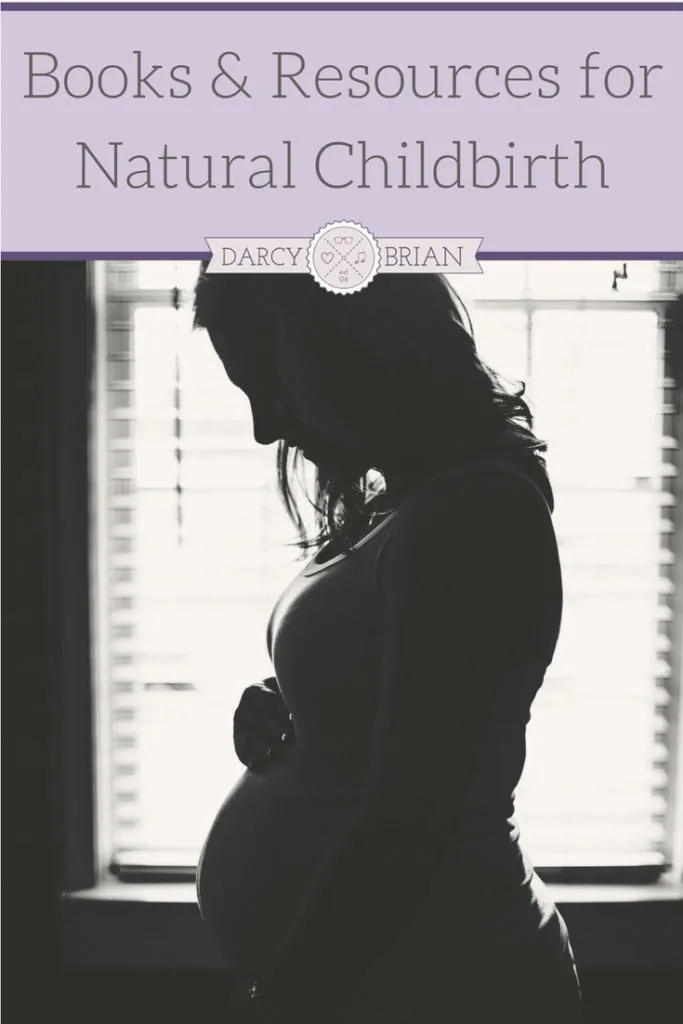Are you planning a natural birth and want more information about natural childbirth? Then you have come to the right place.
First, I would like to point out that I support all moms, regardless of how they give birth.
I know many women seek information on childbirth and ultimately I want to help provide women with resources. I know I did a lot of reading and information seeking throughout my first pregnancy.
Since I gave birth to both of my children vaginally and without pain medication, I also want to share my personal experience with other moms who may find it helpful.

The Ultimate List of Books & Resources for Natural Childbirth
This post contains affiliate links. If you make a purchase through one of these links, I may earn a commission at no extra cost to you.
With more and more research coming out in support of fewer medical interventions during labor and delivery, many moms-to-be set out to have a birth experience that’s as natural as possible. This can mean different things to different people, but generally, moms planning a natural birth look forward to a few specific things:
- Vaginal birth, possibly even after a previous C-section
- Birthing without pain medication
- Waiting for spontaneous labor and avoiding induction practices
- May or may not involve avoiding common newborn procedures such as circumcision, vaccines, and/or eye medications
There’s a lot to think about when it comes to planning a natural birth. Fortunately, there are also many resources available for moms choosing to follow this path. Here are some things to keep in mind along with resources that will help.
Getting Support for Your Natural Birth
It’s so important for women to feel supported during labor. Your partner can help by getting educated about the process and understanding their role. Lots of communication is key.
Check out these resources for labor partners:
Many women also decide to hire a labor doula to attend their birth. A labor doula is someone who is trained to assist during childbirth by offering words of encouragement, physical support, has knowledge of pain relief tactics and labor positions, and can help women advocate for themselves too. They often go through training as well as a certification process and are very knowledgeable and experienced when it comes to natural birth.
I hired a labor doula for my second pregnancy and wish I would have hired her for my first as well! I valued her expertise and felt more relaxed throughout the process. I was concerned about being pressured to be induced because I had gestational diabetes.
One important thing I want to note is that my doula did not replace my husband’s support. He continued to have a supportive role throughout my labor.
Finding a doula may or may not be difficult, depending on where you live. DONA.org has a search feature for finding a doula in your area. You may also have luck asking in local mothers’ groups, talking to your midwife, or reaching out to your local La Leche League (breastfeeding support group).

VBAC: Understanding the Benefits and Risks
For years, many physicians advised that women who had a cesarean delivery (aka c-section) would deliver all of their subsequent babies that way. Now we know that it’s not necessarily the best option for all women, so more and more mothers are choosing a VBAC or vaginal birth after cesarean.
Because there is still some controversy and outdated opinions within the medical community around VBACs, it’s important to find a provider who is open to them so you can discuss whether it’s right for your situation. Learning as much about the risks and benefits, as well as knowing your rights as a patient, will go a long way.
Check out these resources for parents and healthcare providers:
- VBAC Resources on Childbirth Connection
- VBAC Resource Overview from the American Congress of Obstetricians and Gynecologists
Managing Childbirth Pain Without Drugs
The pain of childbirth can seem overwhelming and frightening to many women, especially (but not always) new mothers. Every woman and every labor is different, so it’s not possible to know exactly what to expect, either. Fortunately, there are many time-tested, centuries-old pain management and soothing techniques to utilize during labor.
One popular method of pain management during labor is the Bradley method, which encourages the participation of the baby’s father as a birth coach. TheBradleyMethod.com offers a lot of information on this technique – you may even be able to find a class in your area that teaches the principles of this method.
Experiencing childbirth is incredibly personal and one’s perspective is affected by a variety of factors. I recall having a conversation with a fairly new mom years before I got pregnant. She expressed that delivering her baby without drugs was one of the more painful experiences in her life.
This scared me a little, but the more I learned about childbirth, labor positions, and pain management techniques, the more confident I felt. The unknown is scary, so knowledge helped erase many of my fears.
I felt incredibly empowered after giving birth to my daughter naturally, which made me feel more confident to also give birth to my son without using pain medication.
I’m not going to lie – it was painful and uncomfortable at times. However, my experience didn’t match the high level of constant pain I expected. I think I hurt more the day after delivering my babies when my entire body felt sore and exhausted!
Although we attended childbirth classes during our first pregnancy, we didn’t follow one specific method. I took everything I learned and tried different things while I labored including changing positions, listening to music, and squeezing my husband’s hand.
I eventually found what worked best for me. Focusing on the ceiling, breathing through my contractions, and silently repeating a mantra helped as well as focusing inward and allowing myself to vocalize on the exhale.
Here are a few resources you may find helpful:
- Natural Childbirth the Bradley Way is a comprehensive overview of the husband-led childbirth techniques known as the Bradley method
- Ina May’s Guide to Childbirth is one of the most commonly recommended books out there about natural childbirth in general. Ina May Gaskin was a very experienced midwife who focused on a female-centered model of care.
- Mindful Birthing outlines a modern approach to natural pregnancy, birth, and baby care.
Finally, it’s important to remain open and flexible with your birth plan. (This is the birth plan template I used and it is fantastic.) When it comes down to it, parents and medical professionals should have the same goal in mind: delivering a healthy baby to a healthy, happy mama. Surrounding yourself with people you trust and empowering yourself with information and knowledge is the ultimate first step.

Love to read birth stories?
- My Daughter’s Birth Story: Part One
- My Daughter’s Birth Story: Part Two
- Xander’s Birth Story aka How to Give Birth at the Hospital in 10 Minutes
- An Amazing Twin Birth Story: Part 1
- An Amazing Twin Birth Story: Part 2

Darcy is the founder of “Life With Darcy and Brian,” where she combines her love for education, board games, and crafting to create engaging learning experiences for kids. Her creative projects and writing have been featured in outlets like The Toy Insider, CafeMom, Mom.com, Parents.com, Country Living, and The Pioneer Woman.

